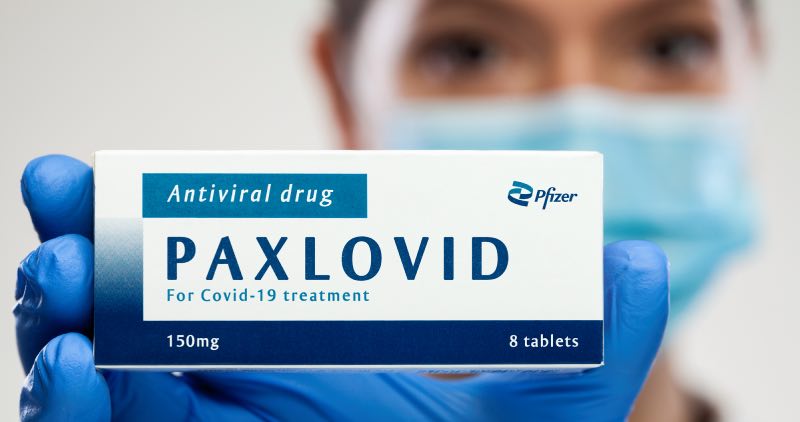5 reasons why PAXLOVID got a bad rap
Summary:
- It works against all known strains of COVID-19.
- It reduces the incidence of Long Covid.
- The components have been used safely for years, and the medication interactions are manageable.
- Paxlovid should be started within the first five days of illness.
- It tastes terrible, but it’s only for five days.
- It reduces hospitalizations, death, and immediate and delayed complications.
(1) It doesn’t work very well? Not true.
Paxlovid resulted in an 89% reduction in hospitalizations and deaths in a trial of high-risk patients.
It works on all variants (including Delta and Omicron). Unlike the vaccinations, which are specific to the antigens on COVID-19 spike protein, Paxlovid attacks the proteases in any cell that produces the virus. Proteases strike specific targets even when antigens change. Present COVID-19 variants do not respond to the intravenous immunoglobulin treatment given to President Trump. When President Biden got infected with COVID-19, white house physicians, lacking an immunoglobulin, gave him Paxlovid, and he was better in 48 hours.
It works on everyone. The magnitude of benefit was unaffected by vaccination or booster status, prior COVID infections, or unvaccinated status. It was the same for men and women as well as for ages > 70 and age < 60. Paxlovid therapy will start shortly for younger patients (who are at low risk for hospitalizations and deaths but at increased risk for long COVID).
Long safety record. Protease inhibitors are the keystone to the lifelong treatment of HIV, and some people have taken them for over 40 years with no significant side effects.
(2) There are medication interactions – but they can be managed.
The potential medication interactions due to the ritonavir component of Paxlovid are unduly emphasized. There are many drug-interaction checkers for Paxlovid. The one from the University of Liverpool is user-friendly, color- and icon-coded. People can avoid most interactions by discontinuing the medication of concern for the length of the Paxlovid treatment, five days. More detailed charts are available online. The number of people suffering adverse reactions from withdrawing a customary medication for Paxlovid treatment is vanishingly small.
(3) Concerns over rebound.
The proteases in Paxlovid reduce the amount of virus by 95%. From that point, most infections will resolve. There will still be a residual number of viruses in circulation, and their multiplication forms the basis for rebounding. The rebound is a resurgence of the original infection, but levels of the virus remain lower than the initial infection, and symptoms are milder. Rebound has unfortunately been exaggerated: clinical symptom rebound can occur from any COVID-19 infection, including those not treated with Paxlovid. The incidence of Paxlovid rebound is in the range of 10%. That concern should not be a reason to withhold treatment.
(4) The roll out was confusing
While the vaccine rollout was tumultuous because of the “mandate.” The changing messaging from all levels of government invited chaos in the public square. But the vaccine also had an orderly sequence of who should receive the vaccine and why.
The Paxlovid roll out was subdued in comparison. There was no mandate and determination of who should receive the medication was an algorithm. It is hard for people from any political stripe to object to something like an algorithm. CVS has a simplified version explaining Paxlovid eligibility on its webpage.
The FDA authorized Paxlovid for people ages 12 and older who weigh at least 88 pounds. But in order to qualify for a prescription, you must also have had a positive COVID-19 test result and be at high risk for developing severe COVID-19.
High risk means you must either have certain underlying conditions (including cancer, diabetes, obesity, or others) or be 65 or older (more than 81% of COVID-19 deaths occur in in this group). The more underlying medical conditions a person has, the higher their risk for developing a severe case of COVID-19, according to the CDC. It appears that eligibility may be expanded to age 50, while the blanket criteria of over 65 may be fine tuned for the very healthy. Once again, go to the CVS webpage for updates. It must be used cautiously in renal and hepatic impairment.
(5) It prevents long covid
The Veterans Health Administration, the largest healthcare system in the United States, looked at 90-day outcomes of about 9000 Paxlovid-treated patients and approximately 47,000 controls. Not only was there a 26% reduction in Long Covid, but examining problems in major organ systems, symptoms in 10 of 12 were significantly reduced with Paxlovid, including pulmonary embolism, deep vein thrombosis, and neurocognitive impairment.
Conclusion:
Overall, I consider the benefits outweigh the risks.
Dr. James Edward Katz. MD, MPH

